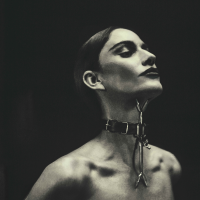Home » Jazz Articles » Live Review » Branford Marsalis at The Ohio Theatre
Branford Marsalis at The Ohio Theatre

Ohio Theatre
Cleveland, Ohio
October 10, 2019
Branford Marsalis is a jazz chameleon. Few saxophonists could go from playing his brother Wynton's straight-ahead outfit to pursing cross over opportunities with pop-star Sting and hip-hop legend Guru to now making music with Gabriel Prokofiev, the great-grandson of pioneering Russian composer Sergei Prokofiev.
On October 10 at the Ohio Theatre, all these experiences came together for an experience that did not disappoint. His set offered a roller coaster ride through jazz styles, from his bandmates modern experimental pieces, to post-bop, to 1930s standards that Marsalis grew up hearing in New Orleans. The concert was presented by Cuyahoga Community College (Tri-C) Jazz Festival.
The band opened with "Dance of the Evil Toys" by bassist Eric Revis. Marsalis introduced the song by saying that Revis claimed it was a love song, but that it does not express love he's ever heard of, establishing that "Dance of the Evil Toys" was not a happy go lucky standard. The band set the tone with a quiet menace before exploding into a kaleidoscope of sound. Drummer Justin Faulkner expressed the very essence of his being through rhythm, his face tightening into a grimace, his body almost falling off his drum throne, as his sticks pounded against the cymbals. When it was time for pianist Joey Calderazzo to solo, his hands jumping off the piano like kids on a trampoline, Marsalis moved to the back of the stage, almost hiding behind his bassist, to give the band the spotlight they deserved.
Once the song ended Calderazzo discovered something; one of the piano keys is slightly sharp.
"Don't play that note," replied Marsalis to his drummer's efforts to fix the problem.
Calderezzo dampened the piano strings to fix the problem, and the band launched into the next song. Immediately however Marsalis himself hit a sharp note, and Calderazzo jokingly handed him some tape. This sense of levity, with the band trading jokes, both musical and verbal, made the concert a showcase in not only how to play an instrument but how to connect with a crowd.
At a masterclass Marsalis gave to students from the Tri-C jazz program before his concert, he emphasized the importance of listening to the players around you. Marsalis said that the ability to listen and adjust what you are doing to fit the band and tell a story is necessary to take jazz beyond the practice room.
"Good stories have one climax, maybe two, not 25," said Marsalis. "You have to find the places to set it up, so the explosions have more effectiveness when they occur."
Marsalis is a firm believer that young players need to have a knowledge of tradition and the players from the genre's formative years of the '20s '30s and '40s like Lester Young.
"You have to study them, not the way they teach them in school. Music is one of the simplest systems in the history of systems," said Marsalis. "There are only 12 notes, 12 sounds. You are not going to find any new notes. The thing that makes the music is how musicians negotiate emotion through sound. When I tell you to listen to Lester Young, I need you to listen to how he sounds and how he plays what he plays. What he plays is almost irrelevant."
Marsalis's favorite saxophonist while growing up was David Sanborn, a player most known for smooth crossover jazz. Though the quartet's adventurist music is far from crossover, the influence of Sanborn is evident in Marsalis's disdain "music for musicians" and how performers can often show off their techniques to the determinant of a song. He told musicians not to listen for licks or time signatures, but to listen for musical ideas that are applicable across songs and changes.
"Musicians have this obsession with changing keys. I played in an R&B band for five years, and the singer only sung in two keys E and G. At no time did anyone in the audience come up and say 'good god can you change the key.' The audience doesn't hear the key," said Marsalis. "What we've done is we've created these mechanisms where we basically have conversations with ourselves. If you go to the Vanguard and hear a guy play "Cherokee" in 12 keys a musician says 'that's incredible,' a regular person says "is he still playing." No one wants to hear 12 choruses of anything they don't know if it's good or not, but they know its long though."
A cover of pianist Andrew Hill's "Snake Hip Waltz," a bouncy post-bop number, was an immediate highlight with one of the tightest grooves the band achieved all night. To follow up, the bouncy post-bop Branford immediately led to an experimental soundscape for "Life Filtering from the Water Flowers." Marsalis sub toned, while Revis created a prepared bass by sticking drum sticks in between his upright strings, slapping against them, and using the sticks as slides. Calderazo stuck his hand in the piano to mute it, while Faulker slid his hands up and down one his sticks while rubbing it against his snare.
"The biggest problem I have with jazz that I hear is musicians who are in the way," said Marsalis. "The moment someone says, "how can I make that hip" they're in the way."
Marsalis did not in his own way at the Ohio Theatre. His concert felt like a five-person dialogue between the four-band member and the audience. Like any genuine conversation, there were occasional lapses of the tongue, but that is a small price to pay for a genuine experience.
"You have to understand that what I'm asking you to do is jump off a cliff, fully knowing that before you hit the ground, the mattress is going to appear," said Marsalis. "That's what you have to believe as opposed to the popular, what if we put the mattress there first so I know it's there and then I'll jump?, that's the harmonic method know it first and then play it. I'm saying just jump out there and play it. There's nothing wrong with crashing. It's like riding a roller coaster there's ups and there's downs."
Tags
Live Reviews
Matt Hooke
United States
Ohio
Cleveland
Branford Marsalis
Justin Faulker
Joey Calderazzo
Lester Young
David Sanborn
Andrew Hill
PREVIOUS / NEXT
Branford Marsalis Concerts
Support All About Jazz
 All About Jazz has been a pillar of jazz since 1995, championing it as an art form and, more importantly, supporting the musicians who make it. Our enduring commitment has made "AAJ" one of the most culturally important websites of its kind, read by hundreds of thousands of fans, musicians and industry figures every month.
All About Jazz has been a pillar of jazz since 1995, championing it as an art form and, more importantly, supporting the musicians who make it. Our enduring commitment has made "AAJ" one of the most culturally important websites of its kind, read by hundreds of thousands of fans, musicians and industry figures every month.


























